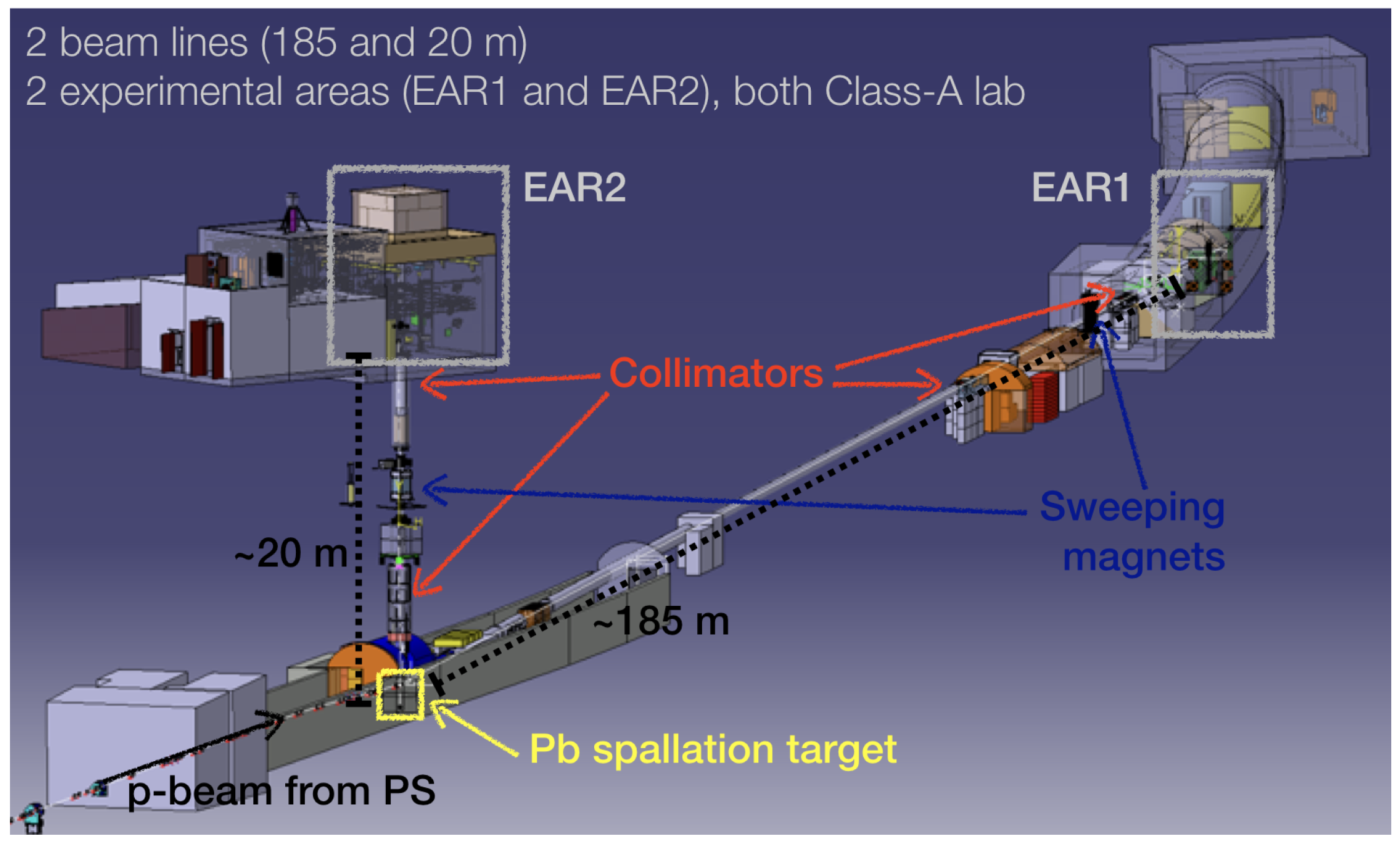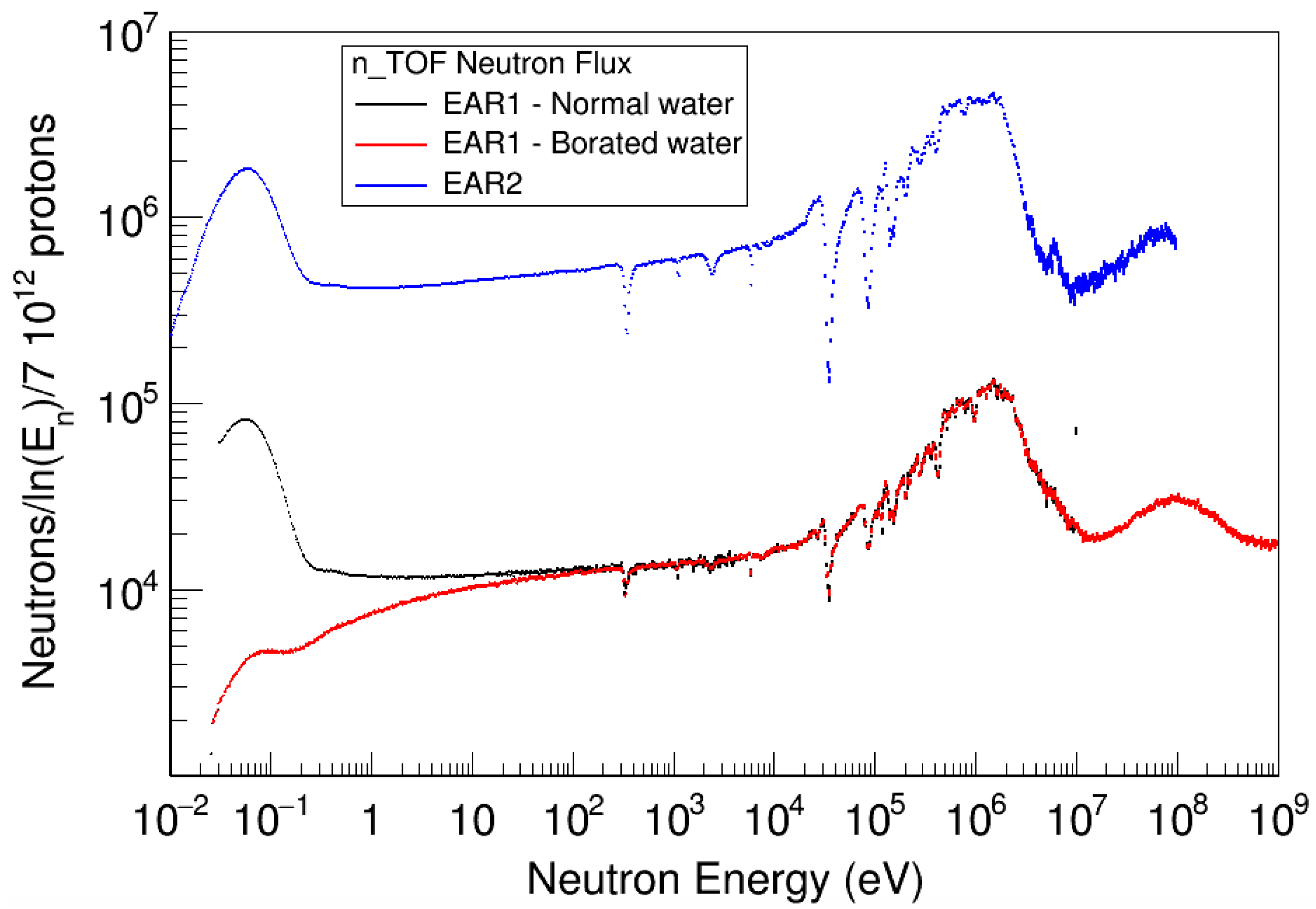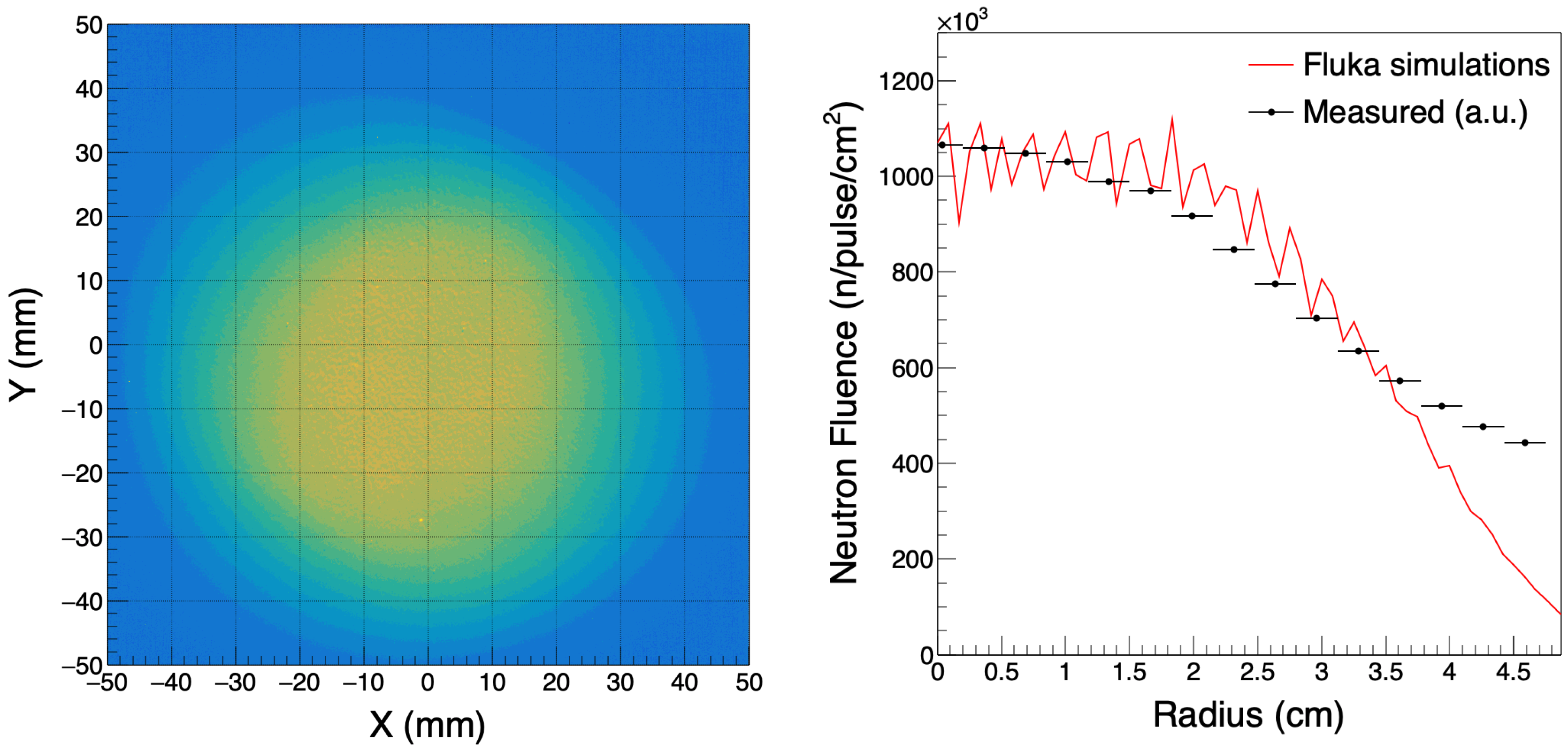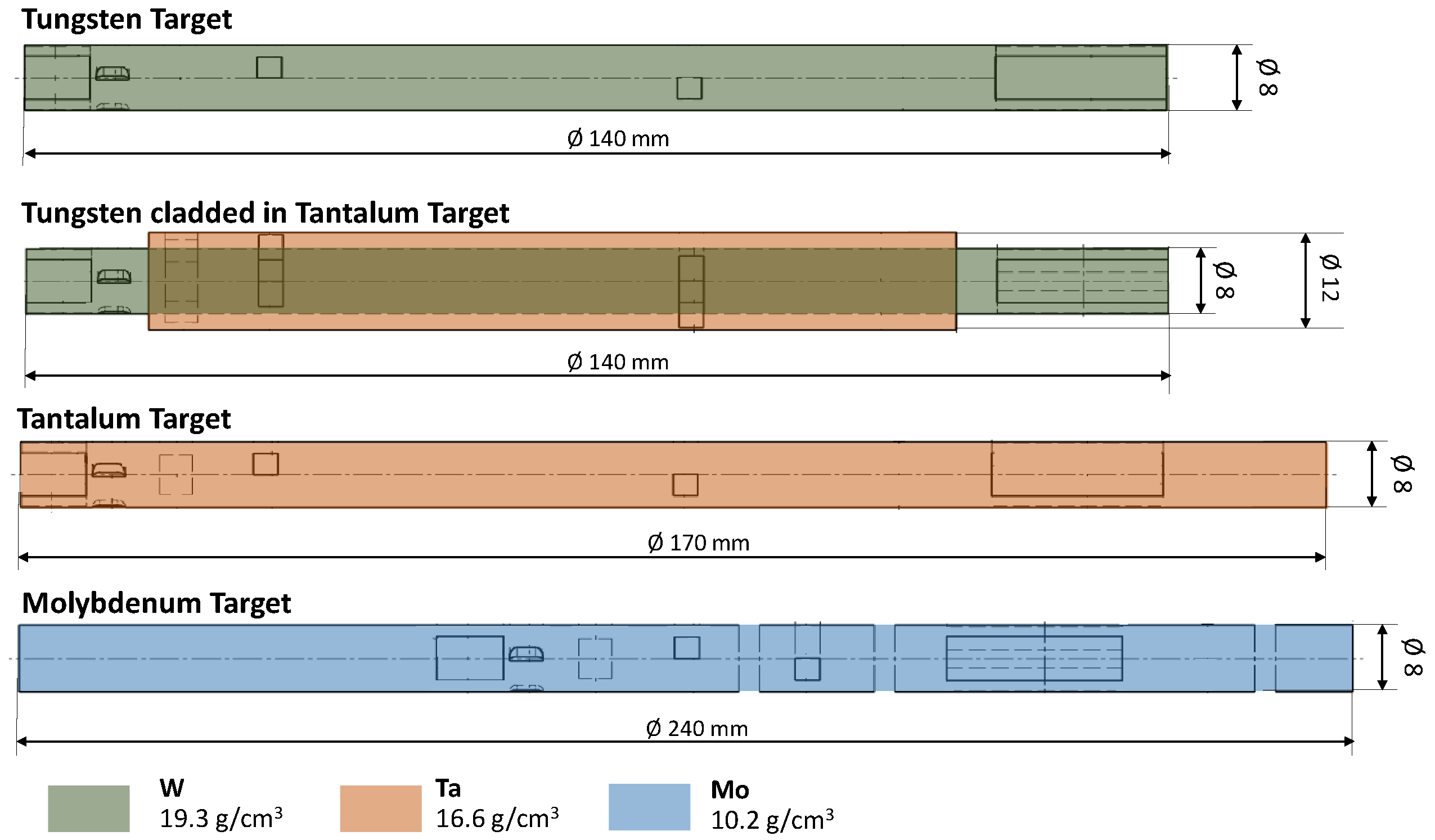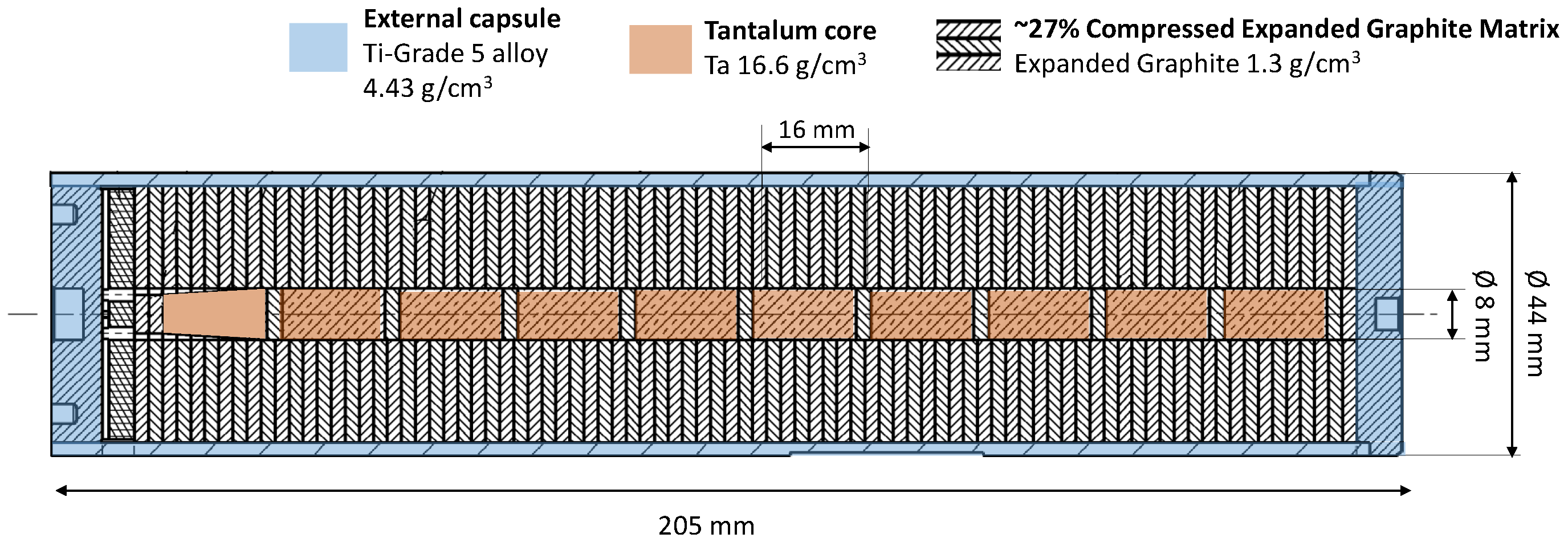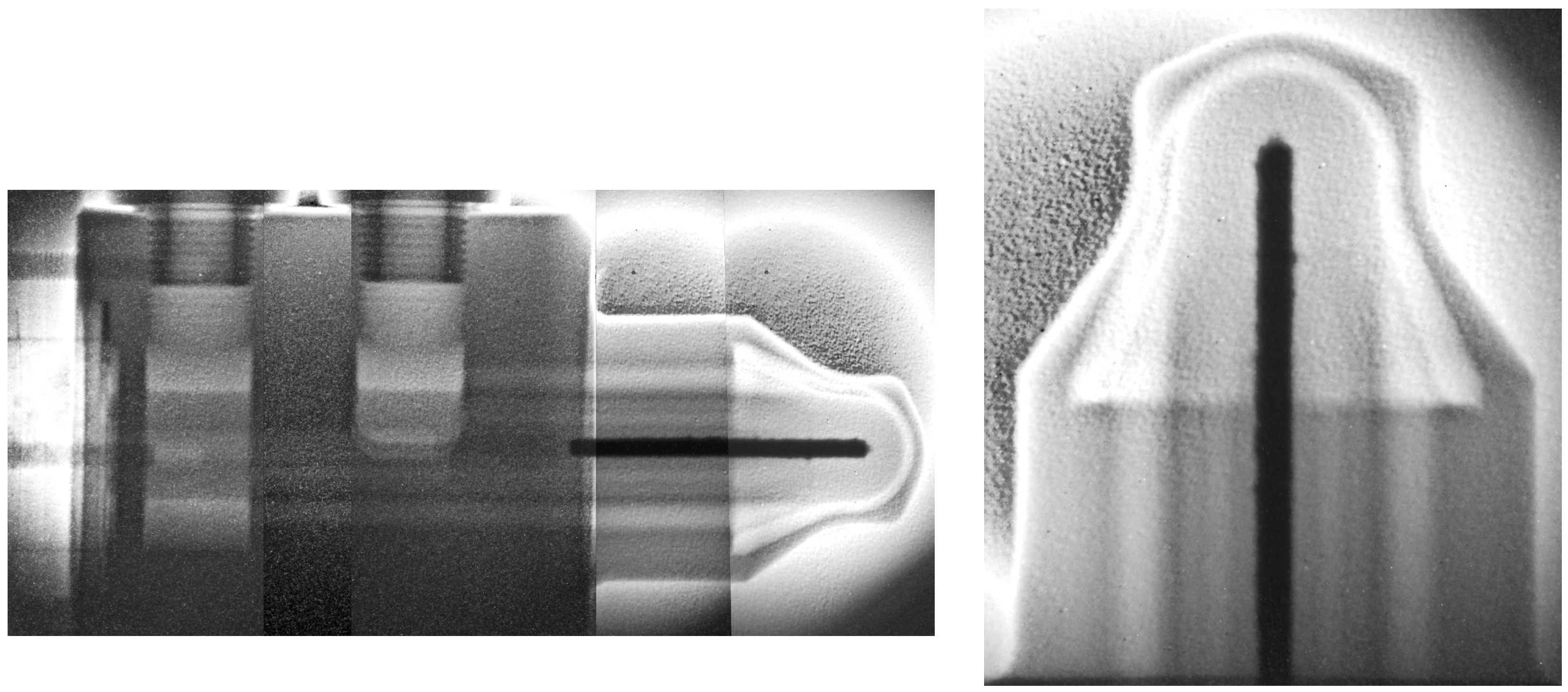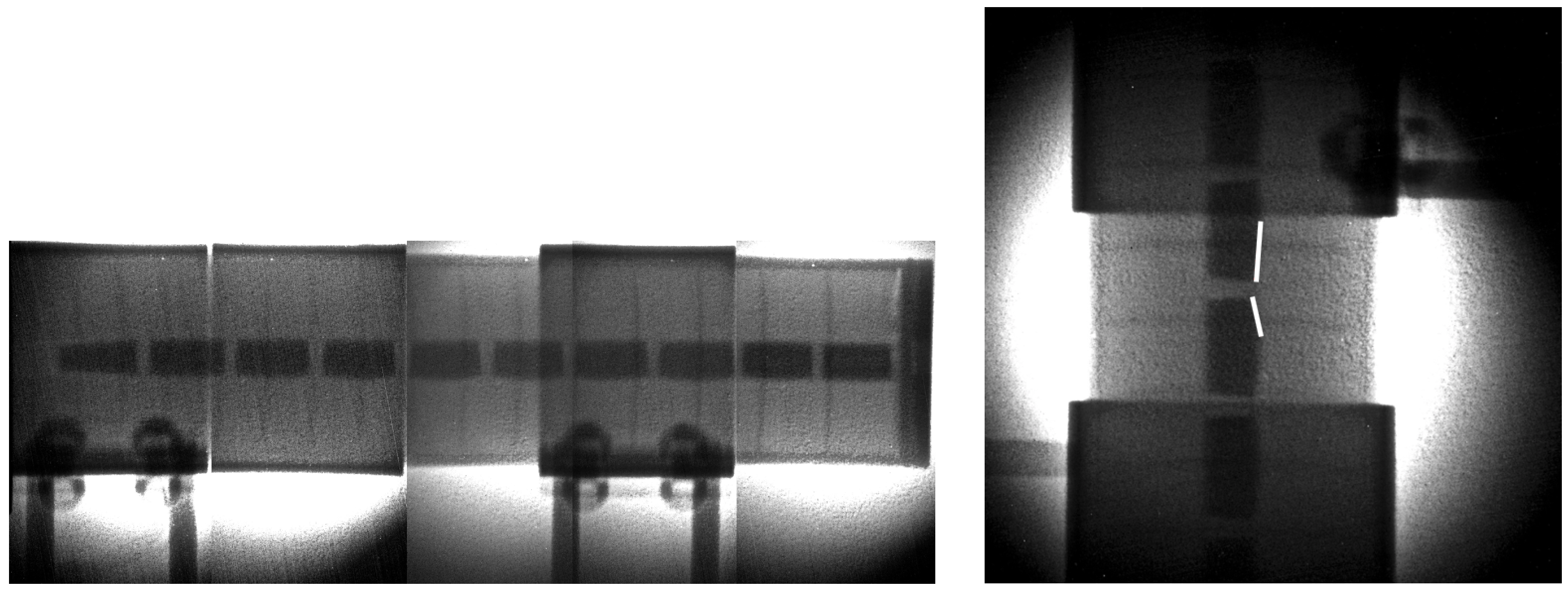1. Introduction
Neutron imaging is a well-developed non-destructive analysis method, exploited for a variety of applications from material science to aerospace technologies [
1,
2,
3]. Due to their peculiar interaction with matter, neutrons act as probes penetrating thick-walled samples and providing an image of the transmitted radiation, which intensity depends on the thickness of the material layers and on the specific attenuation properties of that material. In this regard, neutron radiography can be assimilated to X-rays. However, while X-rays are attenuated more effectively by materials with high-Z, neutrons allow to image light materials, such as hydrogenous compounds, with high contrast, making the two imaging methods complementary to investigate the properties of object internal structures.
Several dedicated facilities are operating worldwide in order to provide high performance neutron imaging stations, in particular at research nuclear reactors and at spallation sources [
3].
A neutron radiography testing station has been recently developed [
4,
5] exploiting the neutron beam of the n_TOF Experimental Area 2, located at the shortest distance from the spallation target [
6], successfully inspecting the inner structure of several targets previously irradiated at the HiRadMat facility of CERN [
7] and of a spent antiproton production target used in the Antiproton Decelerator (AD) target area of CERN. The characteristics of the n_TOF neutron beam for the imaging setup will be here presented, together with the results obtained. The possible further developments of neutron imaging capabilities of the n_TOF facility in terms of detection-systems and beam-line upgrades will also be outlined.
2. The n_TOF Facility
The neutron Time-Of-Flight facility of CERN, called n_TOF, started its operation in 2001, based on an idea by C. Rubbia [
8], providing a very high-resolution neutron energy spectrometer with the aim of measuring neutron-induced reaction cross sections. The facility ran from 2001 to 2004 (n_TOF Phase-1) and, after a four years stop it resumed operation at the end of 2008 until the end of 2012 (n_TOF Phase-2). During the Long Shutdown 1 (LS1) of CERN, a second short 20 m flight-path [
9], complementing the existing 185 m one, has been constructed from May 2013 and completed in July 2014, starting the n_TOF Phase-3.
In the facility, neutrons are produced by spallation reactions induced by a 20 GeV/c pulsed proton-beam from the CERN Proton Synchrotron on a water-cooled lead target. The pulsed neutron source is operating together with a moderation system, consisting of a 4 cm layer of borated and demineralized light water for the first and the second experimental areas, respectively, with the purpose of widening the neutron energy spectrum down to the epithermal and thermal regions and to enhance the neutron-energy resolution. In this way, the n_TOF neutron beam covers about 11 orders of magnitude in energy from thermal to GeV in the first experimental area (EAR1), and to hundreds of MeV in the second experimental area (EAR2). The aim of borated water is to suppress the in-beam 2.2 MeV -ray background coming from thermal neutron capture in hydrogen.
From the target two beam lines start: the first, 185-m long and leading to the experimental area 1 (EAR1), is going along in the horizontal plane with an angle of 10° with respect to the impinging proton beam, while the other extends 20 m vertically on top of the target before reaching the second experimental area (EAR2). Both lines are equipped with two collimators each, of which the second is located immediately before the entrance of the experimental areas to give the neutron beam its final shape. Located in between the two collimators a so-called sweeping magnet is deviating the remaining charged particles that are travelling along the neutron beam. In
Figure 1 a scheme of the beam-lines and their elements is shown.
In
Table 1 the main characteristics of the neutron beam in the two experimental areas are listed. As can be inferred, the two areas have complementary features. If in fact EAR1 is best suited for high-resolution measurements, particularly in the resolved resonance region, and to extend cross-sections to the high neutron energies (
MeV), the exceptionally high instantaneous intensity of the neutron beam in EAR2, with about
neutrons per 30 ms-long bunch, allows to measure cross-sections of very low mass samples (<1 mg), radioisotopes with short half life, and reactions with very small cross-sections. Recently, the second experimental area has been exploited as a neutron imaging facility, counting on a fluence of about 10
6 neutrons in the thermal energy range (
eV). A comparison of the neutron fluence in the two experimental areas is presented in
Figure 2, where also the difference due to the choice of borated or demineralized water as moderation liquid for EAR1 can be seen.
4. Experimental Samples
In order to validate the neutron imaging setup while at the same time providing useful technological information, five different samples have been tested within three imaging sessions in 2015, 2016 and 2017. All of these samples are related to operationally-related and R&D activities launched at CERN for the design and manufacturing of a new set of antiproton production targets (named AD-Target) [
14]. The obtained images—in addition to validating the principle of the neutron imaging technique at n_TOF EAR2—had a direct technical application within this project.
Antiproton production requires the use of a very high density metal as target material and a very focused and intense primary proton beam impacting onto it. This leads to a huge and fast energy deposition in the bulk of target material, with its subsequent sudden increase of temperature and appearance of violent stress waves, which can eventually fracture it [
15]. This phenomena has been extensively studied both numerically [
16] and experimentally [
17,
18]. For the latter, tests using real proton beams were carried out under the described conditions using CERN’s HiRadMat facility [
7]. In this context, neutron imaging arises as a very convenient non-destructive technique to evaluate the damage in these high density metals after such tests, since conventional techniques as X-rays radiography cannot penetrate the target materials to reveal its internal state. In addition, the fact that the experimental area where the neutron imaging was performed (EAR2) is already categorized as a class-A lab, authorized to deal with radioactive samples and unsealed sources, simplified significantly these post-irradiation inspections, since the tested materials are considerably activated and their transport to other imaging facilities would involve formal approval of regulatory agencies. The geometry and characteristics of the three types of inspected samples are described in the following subsections.
4.1. AD-Target Designs
Figure 6 shows simplified drawings of the two inspected antiproton targets. The design and manufacturing of such targets dates back to late 1989 and corresponds to the target concept employed for antiproton production at CERN since then up to 2018 [
19].
Even if there are small differences in the geometry of the two targets, both have in common their two-piece envelope assemblies in titanium grade-5 alloy 100 mm in external diameter, the 15 mm diameter graphite containing matrix, and the 3 mm diameter iridium core. During operation, proton beams (coming from the left) would impact such core, leading to a sudden deposition of energy and thermo-mechanical load.
The main difference between the inspected targets is that the one of
Figure 6a was a spare never used in operation (not radioactive), while the one of
Figure 6b was in operation for around 8 years, receiving up to
proton beam impacts. This second target was therefore significantly radioactive (residual dose of 10 mSv/h at 10 cm) and contaminated at the surface, with its iridium core potentially damaged and/or fractured.
The neutron imaging of the non-radioactive spare target was carried out both in the sessions of 2015 and 2016 (using a small and a big collimator respectively) while the activated one was inspected only in 2017, once the imaging methodology was well established.
4.2. HiRadMat-27 Experiment Targets
The HiRadMat-27 experiment was carried out in 2015 in order to obtain, in a controlled environment, analogous conditions to the ones taking place in the AD-Target core [
17]. Thirteen targets made of refractory metals, all potential candidates for core materials in a new AD-Target design, were exposed to proton beam impacts in order to crosscheck numerical simulations and assess their response at such conditions.
Figure 7 shows the geometry of some of these targets which, after the experiment and before other destructive inspections, were brought to EAR2 for neutron imaging. In this way, internal cracks induced by the proton beam could be identified, thus aiding in the selection of relevant areas to cut for further studies.
As shown in the figure, most of the inspected targets were 8 mm in diameter with densities from 10.2 to 19.3 . In addition, one of the targets was an 8 mm diameter tungsten rod cladded in 2 mm thick tantalum, leading to an external diameter of 12 mm. During the experiment, these targets were subjected to a relatively low number of proton beam pulses, therefore, their residual doses were only in the order 30 μSv/h and no remote manipulation was necessary.
4.3. HiRadMat-42 Experiment Target
Similarly to the HiRadMat-27 experiment, the HiRadMat-42 [
18] experiment was performed in 2017 for testing a first, simplified and scaled, prototype of the new AD-Target design, shown in
Figure 8. This target consisted of 10 rods of tantalum 8 mm in diameter and 16 mm in length embedded in a matrix of compressed expanded graphite and encapsulated in a titanium grade-5 alloy. Differently from the HiRadMat-27 experiment (in which only a few pulses per target were impacted), this target was exposed to 50 proton beam impacts, aiming at investigating progressive material damage in the Ta core. During the neutron imaging at n_TOF, the dose rate at contact of this target was in the order of 300 μSv/h. A full neutron tomography of this target was also performed at the PSI-SINQ NEUTRA beam line [
20], with results presented in Reference [
18].
5. Experimental Results of Neutron Imaging at EAR2
As already introduced, the neutron imaging method has been validated in three separate campaigns in 2015, 2016 and 2017, using the small (70 mm) collimator in 2015 and the big (96.8 mm) in 2016 and 2017 respectively.
During the tests in 2015 and 2016, the non-irradiated AD-Target introduced in
Figure 6a has been investigated. Results are shown in the two panels of
Figure 9 (left for the small and right for the big collimator, respectively). As it can be seen, in both cases the inner iridium core of the target is perfectly visible with a very good contrast, which proves the feasibility of the technique. While with the small collimator the spatial resolution is better due to the lower
ratio, the advantage in using the big collimator is a much larger homogeneously irradiated area, with a higher neutron intensity and improved contrast.
Following the successful proof of concept, the irradiated samples described in
Section 4 have been inspected during the campaign of 2017 with the goal to examine their inner structure and to identify potential material damage. In this respect, the geometrical and material constraints of the samples played an important role in planning the beam-time per radiograph. In fact, for the HiRadMat-27 targets that did not present any encapsulation and for the HiRadMat-42 target, with a more complex design but still light enough, statistics of about
thermal neutrons/cm
2—resulting in an average of 45 min per radiograph—was sufficient to obtain the desired contrast. On the contrary, the old AD-Targets shown in
Figure 6 consist of a denser assembly where the inner iridium core is embedded in the graphite matrix and the titanium alloy envelopes (up to 100 mm of external diameter). In this case an average of
thermal neutrons/cm
2—for a measuring time of 2 h and 40 min—were accumulated per radiograph to achieve the desired contrast.
The results obtained are presented in
Figure 10,
Figure 11,
Figure 12 and
Figure 13. Since, as described in
Section 3.1, the beam spot was 9 cm in diameter, to obtain a full radiograph of the objects under investigation several pictures had to be taken with the support of the movable table, namely six for the AD-Target, seven for the HiRadMat-42 target, and two for each of the HiRadMat-27 targets. The relevant parameters for the experimental setup are summarized in
Table 2 for each target. It is important to keep in mind that the geometry of the n_TOF beam line is not designed for imaging applications, presenting, for example, a first collimator close to the neutron spallation source. Therefore, the formulas normally used to estimate the geometric blur and the achievable spatial resolution are in this case less representative of the real achieved resolution.
As can be seen from the figures, the higher neutron fluence obtained with the big collimator allows one to clearly distinguish and investigate the inner structures of the samples presented in
Section 4. For instance,
Figure 10 shows the neutron-radiograph of the previously proton irradiated AD-Target. In particular, the right panel of the figure distinctly shows a non-uniformity in the contour of the iridium core, which was not present in the ones obtained from the non-irradiated spare AD-Target (
Figure 9). This non-uniform contour along the core of the proton irradiated AD-Target is therefore a clear indication of its fragmentation and internal damage due to the extreme stress waves induced by the proton beam impact during operation, as suggested by numerical simulations in Reference [
15,
16] and verified after target opening (detailed in a forthcoming paper).
In
Figure 11, the inner tantalum rods of the HiRadMat-42 target assembly experienced permanent plastic deformation and are slightly bent due to excitation of bending modes induced by the thermo-mechanical load of the proton beam impact. This conclusion has been confirmed by the additional tomography performed at the NEUTRA line in the SINQ facility in PSI [
18], as well as after the subsequent target opening. The results of the neutron tomography performed at PSI indicated that the Ta cores suffered internal voids (up to 0.8 mm size) [
18]. Unfortunately, the voids cannot be observed in the single neutron imaging of
Figure 11 since a higher spatial resolution would be necessary to be sensitive to the minimal absence of Ta material in these voids.
Regarding the HiRadMat-27 targets, a more significant result has been obtained for the tungsten target cladded in tantalum. As shown in
Figure 12, two major fractures have been detected, one longitudinal and one transverse. The longitudinal one reached the surface and is also externally visible, while the transverse one is enclosed in the tungsten core and is only revealed by the radiograph.
Another interesting result obtained with the HiRadMat-27 targets is the expected angle-dependence of the method, meaning that the radiographs showed different internal structures depending on the orientation of the sample with respect to the neutron beam. This behaviour can be observed in
Figure 13, where two radiographs of one of the tungsten targets are shown before and after a rotation by 120 degrees. The fact that different cracks are detected in the radiographs depending on the orientation is clearly highlighted. This paves the way to potential applications of neutron tomography techniques at n_TOF EAR2 imaging station.
6. Conclusions and Perspectives
The unique characteristics of the n_TOF facility at CERN have been successfully exploited to perform neutron radiography on different irradiated materials and target assemblies. Following the results from three feasibility tests, the experimental setup has been chosen in order to maximize the contrast (i.e., the neutron fluence) and the beam spot, using the bigger collimation system available in the facility. In this configuration, in 2017 several targets—previously irradiated in the HiRadMat CERN facility—have been investigated, analyzing their inner structures and qualitatively assessing their damage.
The successful and promising results obtained in the 2017 measurement campaign could now be used as a starting point to further develop the imaging capabilities of the n_TOF facility. In particular, a new, dedicated, collimation system is being designed to improve the achievable resolution preserving at the same time the high neutron flux necessary for a good imaging contrast. In addition, the measuring station will be equipped with a remote-controlled rotating system in the z-axis, to make it easier to take radiographs at different angles and to improve the flexibility of such studies (e.g., neutron tomography). A camera upgrade is also being foreseen, together with the use of specific masks in order to quantitatively assess the performances of the neutron imaging station at EAR2.
Besides the facility-related improvements, the detection system is also foreseen to be upgraded with a more solid scintillator-optics assembly. In particular, the ZnS was found degrading its time characteristics with the exposure to the high neutron flux—also at neutron energies above hundreds of keV—of the n_TOF facility.
New detection setups are under investigation in order to exploit the time-of-flight technique and characteristics of the facility. Among these is the possibility of coupling the standard imaging system with a fast scintillator to use the Resonance Shape Analysis from the (n, ) reaction to identify the material composition of the object under investigation. In addition, the use of fast neutron detectors, as for example, Micro Channel Plates, could open the possibility of taking material-selective radiographs if the acquisition window of the camera is gated on a resonance specific to a given isotope.
